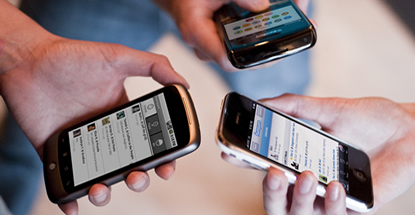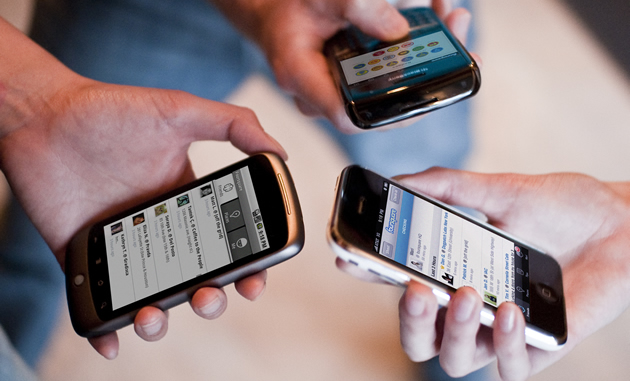The constant connectivity offered by mobile social networking applications, such as Twitter and Facebook, play an important role in overall smartphone satisfaction, according to J.D. Power and Associates’ “second edition” 2012 U.S. Wireless Smartphone Customer Satisfaction Study and 2012 U.S. Wireless Traditional Mobile Phone Satisfaction Study, each released this month.
 The Customer Satisfaction Study, completed by 8,736 smartphone owners, concludes that people who regularly use mobile social media and gaming apps are more satisfied with their phone and spend more per month for wireless service than customers who don’t. In the study, 67 percent of smartphone customers said they have downloaded mobile social networking apps and spend more than 100 minutes per week using those apps. Overall smartphone satisfaction among people using social networking apps was 810 out of a 1,000-point scale — 55 points higher than among smartphone customers who don’t, reports J.D. Power.
The Customer Satisfaction Study, completed by 8,736 smartphone owners, concludes that people who regularly use mobile social media and gaming apps are more satisfied with their phone and spend more per month for wireless service than customers who don’t. In the study, 67 percent of smartphone customers said they have downloaded mobile social networking apps and spend more than 100 minutes per week using those apps. Overall smartphone satisfaction among people using social networking apps was 810 out of a 1,000-point scale — 55 points higher than among smartphone customers who don’t, reports J.D. Power.
Get your game on, get happy
Besides loving social apps, 69 percent of smartphone owners in the study said they have downloaded gaming apps and spend an average of 81 minutes per week playing games. Satisfaction among those using gaming apps was 61 points higher than among those who do not (813 vs. 752, respectively).
The same study also finds that mobile gamers spend $13 more per month, on average, for their wireless service than those who don’t use gaming apps. Likewise, mobile social media app users spend an average of $12 more per month on their service than those who don’t use social media apps.
Apple, HTC and LG are crowd pleasers
The two studies each measured customer satisfaction with traditional wireless handsets and smartphones among owners who have used their current mobile device for less than one year. Satisfaction was measured in several key factors. In order of importance, the key factors of overall satisfaction with traditional wireless handsets were:
– Performance (29%)
– Ease of use (26%)
– Physical design (24%)
– Features (21%)
For smartphones, the key factors were:
– Performance (33%)
– Physical design (23%)
– Features (22%)
– Ease of use (22%)
For the eighth consecutive time the J.D. Power study was conducted, Apple ranked highest among manufacturers of smartphones in customer satisfaction. Apple scored 849 by performing well in all factors, especially in physical design and ease of use. HTC came in second on the smartphone satisfaction scale, with a score of 790.
In the Traditional Mobile Phone Satisfaction Study, LG ranked highest with a score of 726. The Korean company scored well in all four factors among that study’s 6,272 traditional (non-smartphone) mobile phone owners.
Costs drop, but prices matter
The studies also revealed the following key wireless handset usage patterns and purchase trends:
– The cost of a traditional wireless mobile phone averages $56, compared with an average of $66 in 2011. The decline is primarily due to discounts provided by handset providers and wireless service carriers to incentivize sales. In this year’s study, 44 percent of customers reported having received a free mobile phone when subscribing to a wireless service.
– Nearly one-fifth (19%) of smartphone owners this year primarily chose their device based on price, compared with 14 percent a year ago. This may be driven by offers of free or heavily discounted devices from wireless carriers, as 22 percent of smartphone owners said their phone was free, an increase from 18 percent a year ago, says J.D. Power.
– Features have become less of a differentiator in the smartphone selection processes due to an influx of competitive offerings from newer manufacturers. Nearly one-half (47%) of those polled in this year’s study indicated they chose their smartphone primarily because of particular features, such as a camera, the operating system, or social media integration or gaming capabilities, compared with 57 percent just one year ago.
– Nearly two in 10 current smartphone owners reported experiencing a software or device malfunction. Not surprisingly, malfunctions had a significant impact on overall satisfaction in the study — a gap of 90 points between people who experienced software malfunctions and those who do not (799 vs. 709, respectively). Satisfaction among customers who said their device’s software crashes at least once a week averages 663.
Both studies were conducted between January and June 2012.





